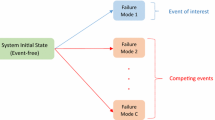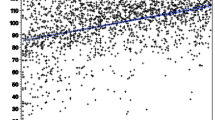Abstract
This paper develops a prognostic technique called the logical analysis of survival curves (LASC). This technique is used to learn the degradation process of any physical asset, and consequently to predict its failure time (T). It combines the reliability information that is obtained from a classical Kaplan–Meier non-parametric curve to that obtained from online measurements of multiple sensed signals of degradation. An analysis of these signals by the machine learning technique, logical analysis of data (LAD), is performed to exploit the instantaneous knowledge about the state of degradation of the asset studied. The experimental results of the predictions of failure times for cutting tools are reported. The results show that LASC prognostic results are better than the results obtained by well-known machine learning techniques. Other advantages of the proposed techniques are also discussed.







Similar content being viewed by others
References
An, D., Kim, N. H., & Choi, J. H. (2015). Practical options for selecting data-driven or physics-based prognostics algorithms with reviews. Reliability Engineering and System Safety,133, 223–236. https://doi.org/10.1016/j.ress.2014.09.014.
Aye, S. A., & Heyns, P. S. (2017). An integrated Gaussian process regression for prediction of remaining useful life of slow speed bearings based on acoustic emission. Mechanical Systems and Signal Processing,84, 485–498. https://doi.org/10.1016/j.ymssp.2016.07.039.
Banjevic, D., et al. (2001). A control-limit policy and software for condition-based maintenance optimization. INFOR, 39(1), 32–50. http://www.omdec.com/papers/control-limitPolicyCbmOptimization.pdf.
Benkedjouh, T., et al. (2015). Health assessment and life prediction of cutting tools based on support vector regression. Journal of Intelligent Manufacturing,26(2), 213–223.
Boros, E., Hammer, P., & Ibaraki, T. (2000). An implementation of logical analysis of data. IEEE Transactions on Knowledge and Data Engineering, 12(2), 292–306. http://ieeexplore.ieee.org/xpls/abs_all.jsp?arnumber=842268.
Boros, E., et al. (2011). Logical analysis of data: Classification with justification. Annals of Operations Research,188(1), 33–61.
Crama, Y., Hammer, P. L., & Ibaraki, T. (1988). Cause–effect realtionships and partially defined Boolean functions. Annals of Operations Research,16, 299–325.
Datong, L., et al. (2012). Data-driven prognostics for lithium-ion battery based on Gaussian process regression. In 2012 IEEE Conference on Prognostics and System Health Management (PHM) (pp. 1–5).
Guillén, A. J., et al. (2016). On the role of prognostics and health management in advanced maintenance systems. Production Planning & Control, 27(12), 991–1004. http://www.tandfonline.com/doi/full/10.1080/09537287.2016.1171920.
Hailesilassie, T. (2016). Rule extraction algorithm for deep neural networks: A review. International Journal of Computer Science and Information Security,14(7), 376–381.
Hammer, P. L., et al. (2004). Pareto-optimal patterns in logical analysis of data. Discrete Applied Mathematics,144, 79–102.
Heng, A., Tan, A. C. C., et al. (2009a). Intelligent condition-based prediction of machinery reliability. Mechanical Systems and Signal Processing,23(5), 1600–1614.
Heng, A., Zhang, S., et al. (2009b). Rotating machinery prognostics: State of the art, challenges and opportunities. Mechanical Systems and Signal Processing,23(3), 724–739.
Huang, R., et al. (2007). Residual life predictions for ball bearings based on self-organizing map and back propagation neural network methods. Mechanical Systems and Signal Processing,21(1), 193–207.
Hyndman, R. J., & Koehler, A. B. (2006). Another look at measures of forecast accuracy. International Journal of Forecasting,22(4), 679–688.
Jardine, A. K. S., Lin, D., & Banjevic, D. (2006). A review on machinery diagnostics and prognostics implementing condition-based maintenance. Mechanical Systems and Signal Processing,20(7), 1483–1510.
Javed, K., Gouriveau, R., & Zerhouni, N. (2017). State of the art and taxonomy of prognostics approaches, trends of prognostics applications and open issues towards maturity at different technology readiness levels. Mechanical Systems and Signal Processing,94, 214–236. https://doi.org/10.1016/j.ymssp.2017.01.050.
Johannes, F., Dragan, G., & Nada, L. (2013). Foundations of rule learning. Berlin: Springer. https://doi.org/10.1007/978-3-642-37747-1_8.
Kronek, L. P., & Reddy, A. (2008). Logical analysis of survival data: Prognostic survival models by detecting high-degree interactions in right-censored data. Bioinformatics,24(16), 248–253.
Li, N., et al. (2017). Force-based tool condition monitoring for turning process using v-support vector regression. The International Journal of Advanced Manufacturing Technology,91(1–4), 351–361. https://doi.org/10.1007/s00170-016-9735-5.
Mohamad-ali, M., Yacout, S., & Lakis, A. (2014). Fault diagnosis in power transformers using multi-class logical analysis of data. Journal of Intelligent Manufacturing,25(6), 1429–1439.
Murphy, K. P. (2012). Machine learning: A probabilistic perspective. Cambridge: The MIT Press.
Pimenov, D. Y., Bustillo, A., & Mikolajczyk, T. (2018). Artificial intelligence for automatic prediction of required surface roughness by monitoring wear on face mill teeth. Journal of Intelligent Manufacturing,29(5), 1045–1061. https://doi.org/10.1007/s10845-017-1381-8.
Ragab, A., et al. (2016). Remaining useful life prediction using prognostic methodology based on logical analysis of data and Kaplan–Meier estimation. Journal of Intelligent Manufacturing,27(5), 943–958. https://doi.org/10.1007/s10845-014-0926-3.
Reddy, A. R. (2009). Combinatorial pattern-based survival analysis with applications in Biology and Medicine. Rutgers University.
Rokach, L., & Maimon, O. (2008). Data mining with decision trees: theory and applications. Singapore: World Scientific.
Ryoo, H. S., & Jang, I. Y. (2009). MILP approach to pattern generation in logical analysis of data. Discrete Applied Mathematics,157(4), 749–761. https://doi.org/10.1016/j.dam.2008.07.005.
Shaban, Y., Yacout, S., & Balazinski, M. (2015). Tool replacement based on pattern recognition with LAD. In Proceedings—annual reliability and maintainability symposium (pp. 1–6), Palm Harbor, FL
Shaban, Y., et al. (2017). Cutting tool wear detection using multiclass logical analysis of data. Machining Science and Technology,21(4), 526–541. https://doi.org/10.1080/10910344.2017.1336177.
Shao, H., et al. (2017). A novel deep autoencoder feature learning method for rotating machinery fault diagnosis. Mechanical Systems and Signal Processing, 95, 187–204. http://linkinghub.elsevier.com/retrieve/pii/S0888327017301607.
Si, X. S., et al. (2011). Remaining useful life estimation—A review on the statistical data driven approaches. European Journal of Operational Research,213(1), 1–14. https://doi.org/10.1016/j.ejor.2010.11.018.
Sikorska, J. Z., Hodkiewicz, M., & Ma, L. (2011). Prognostic modelling options for remaining useful life estimation by industry. Mechanical Systems and Signal Processing,25(5), 1803–1836.
Wang, T., et al. (2018). Data-driven prognostic method based on self-supervised learning approaches for fault detection. Journal of Intelligent Manufacturing. https://doi.org/10.1007/s10845-018-1431-x.
Wu, Q., Ding, K., & Huang, B. (2018). Approach for fault prognosis using recurrent neural network. Journal of Intelligent Manufacturing,9, 99. https://doi.org/10.1007/s10845-018-1428-5.
Ye, L., & Keogh, E. (2009). Time series shapelets. In Proceedings of the 15th ACM SIGKDD international conference on Knowledge discovery and data mining—KDD’09 (p. 947). http://portal.acm.org/citation.cfm?doid=1557019.1557122.
Funding
Funding was provided by Natural Sciences and Engineering Research Council of Canada (Grant No. RGPIN-207-05785).
Author information
Authors and Affiliations
Corresponding author
Rights and permissions
About this article
Cite this article
Elsheikh, A., Yacout, S., Ouali, MS. et al. Failure time prediction using adaptive logical analysis of survival curves and multiple machining signals. J Intell Manuf 31, 403–415 (2020). https://doi.org/10.1007/s10845-018-1453-4
Received:
Accepted:
Published:
Issue Date:
DOI: https://doi.org/10.1007/s10845-018-1453-4




